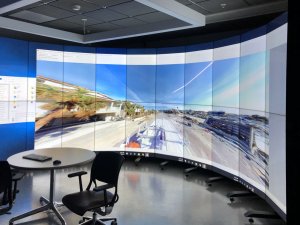
it is important to consider the impacts of climate change and natural disasters in future resilience planning and building. Photo ©Jie Gong.
As the economic impact of climate change on infrastructure continues to grow, it is important to consider these impacts in future resilience planning. CAIT Director Dr. Ali Maher discussed this and more in a recent presentation during the ITRC Seminar Series.
The Infrastructure Technology Resources Consortium (ITRC) Seminar Series on “Resilience and Sustainability of Urban Transportation Infrastructure” has recently been addressing key topics in infrastructure resilience such as safe and secure infrastructure, smart cities, and new technology and resources.
This May, Director of the Rutgers Center for Advanced Infrastructure and Transportation (CAIT) Dr. Ali Maher presented during the seminar series on “Resiliency Considerations in Transportation Infrastructure.”
“Thank you to ITRC for having me for this timely discussion as we and the entire world are struggling with the impact of the COVID-19 pandemic,” Dr. Maher said during his presentation. “The picture that is in front of us contains experiences and lessons that we must learn from and implement into our future transportation and resilience planning.”
Led by the University of Illinois System, Discovery Partners Institute (DPI) provides the community for the Infrastructure Technology Resources Consortium (ITRC) to advance the development of the next generation of national civil infrastructure. ITRC represents partnerships between the state university systems of Illinois, Missouri, and Iowa, and Northwestern University. The University of Illinois System coordinates and leads the research activities of ITRC through DPI.
Dr. Maher’s talk gave a background on climate impacts, updates on current efforts by the Federal Highway Administration, state, and local agencies on resilience integration, a review of the process for integration, latest efforts by CAIT, and possible areas to collaborate looking forward.
The economic impact of climatic change on critical infrastructure continues to grow each year due to insufficient consideration of resilience during planning and construction, he said. Underinvestment in resilience and new technologies and resources could cause future problems and emphasize ongoing infrastructure needs due to the unpredictability of natural disasters and climate events.

The WAVE virtual/augmented reality lab can create environments for bridge inspection simulations, workforce training, and much more.
To address these needs, it is important to build with resilience in mind and consider the use of advanced techniques in condition assessment, disaster data management, decision tools, and emerging areas prime for collaboration between academia and industry, he said.
Specifically at CAIT, Dr. Maher highlighted the recently launched Infrastructure Resilience Program (IRP), designed to research new ways to build more resilient infrastructure while accommodating for the needs of all stakeholders through a multi-faceted approach to resilience. Leveraging data collection and remote sensing using the surrounding area as a living test bed, as well as leveraging diverse, strategic partnerships, the CAIT IRP plans to develop and implement real-world resilience solutions.
“Resilience is commonly defined as the ability of an organization to anticipate, prepare for, and adapt to changing conditions, as well as respond to and recover from disruptions,” Dr. Maher said. “Learning from the impacts of COVID-19 is important as it can provide a foreshadowing of what impacts to expect from climate change and how we must adapt our infrastructure and resilience planning.”

